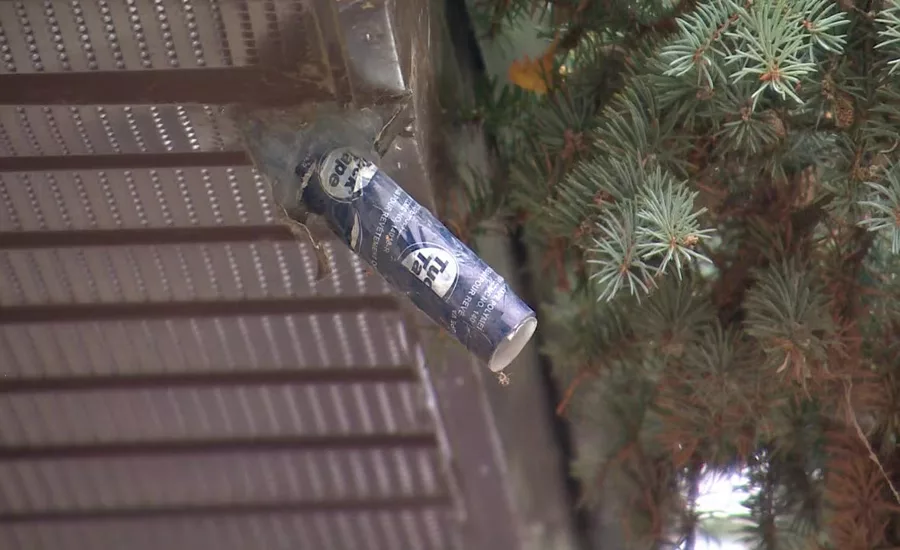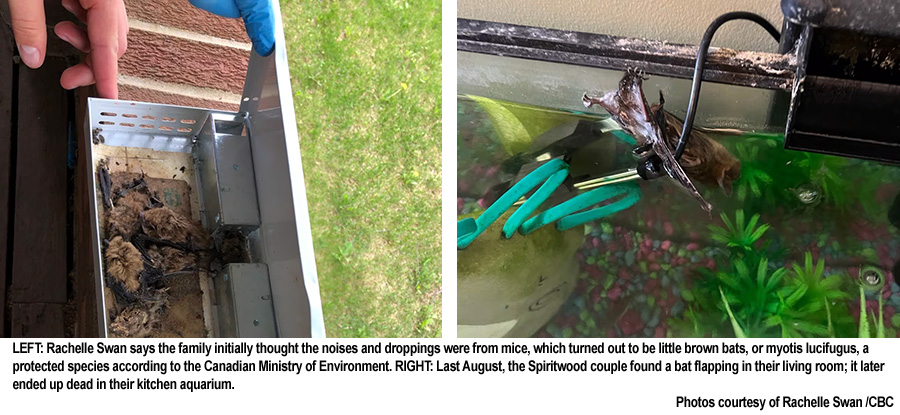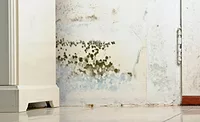Halloween Dispatch
Bat Colony Takes Residence in Family’s Roof, Likely Requiring Complete Tear-Off to Evict
Moving in was simple, but removing the winged mammal won’t be easy given its ‘endangered’ status

A roofing company installed 'bat cones' like the one in the photo above, allowing bats to exit safely but not return.
Mark Brigham, a professor of biology at the University of Regina who has studied bats for 40 years, said the little brown bat, or myotis lucifugus, is a very common species across all of North America but was declared endangered in Saskatchewan about eight years ago because of white-nose syndrome.
— Photo courtesy of the CBC/By Travis Reddaway
Once a year, like, say, Halloween, a story about a home invaded by bats would be considered thrilling. Yet, even then, it would be a stretch beyond the Cineplex; for one family in Saskatchewan, Canada, contending with a cauldron of bats squatting in their roof, it has been an ongoing real-life nightmare.
While screeching, wailing, and squeals may be an appropriate soundtrack for All Hallows’ Eve, for Rachelle and Kelly Swan and their children, the issue has far exceeded the "nuisance" threshold since their mammalian colonists enjoy regulatory protection, making the mammalian expulsion challenging.
"We thought it had gotten in the door or something, but when we found another one outside in our soffit, we were like, OK, maybe something else is going on here," Rachelle told the Canadian Broadcast Company, which first reported the story of when they first found a bat flapping around their living room.
"We called exterminators all over the province, and they just said 'Good luck,'” Rachelle added, recalling the information repeated to her after each new request for help. “They're protected. There's nothing that we can do about them."
The Swan’s home, located in the aptly named town of Spiritwood, population 966 according to Canadian government’s statistics, is in the boreal forest of central Saskatchewan, about 106 miles northwest of Saskatoon, the province’s largest city.

The couple even called conservation officers, who set them up with a roofing company specializing in relocating bats. That adventure, the women said, took two days of work, more than 60 cans of silicone to seal all penetrations, installation of one-way "exits" for the bats to depart — and $5,000.
The family was told to wait until spring, as the bats were hibernating.
"The mice with wings," as Rachelle calls them, can enter a roof through a hole as small as the width of a human finger. "All winter, we heard them up in the main beam where they're the loudest; our kids heard them in their walls and the roof," she added, asking rhetorically, "Are they partying up there?"
When spring rolled around, they found another one in their kitchen aquarium and six more in a mouse trap they set out thinking they had seen mouse droppings. A follow-up visit from a conservation officer culminated in him getting bitten by one of the brown bats.
"Public health told us our family is now considered at risk," Rachelle said. “Over the course of two weeks, our family of five had to get 47 needles," as bats can carry the rabies virus. The family has to go regularly for boosters on their rabies vaccines until this is dealt with.
Worse still, Kelly is also in remission from cancer and said she is vulnerable to histoplasmosis, a lung infection caused by breathing spores of a fungus often found in guano, the scientific name for bat "droppings."
Bats’ Lives Matter
Canada’s Ministry of Environment said the bats and their place of habitation are protected from interference, harassment and killing under the country’s Wildlife Act.
"Two of the eight bat species found in Saskatchewan are also listed as endangered under the federal Species at Risk Act, and it is illegal to kill, disturb or exclude bats without a permit pursuant to The Wildlife Act," the statement said. "Bats can only be excluded, allowing exit but not re-entry, from buildings in May or September with a permit under Saskatchewan's Bat Exclusion Policy. Outside of May or September, considerations will be made by the Ministry of Environment on a case-by-case basis."
The ministry noted that many bat species risk collapsing from habitat loss or a fungal disease called white-nose syndrome, which has killed more than 12 million bats in North America and has no known cure. And, while bats play a vital role in the ecosystem — and are appreciated for their fondness for eating mosquitoes — it’s cold comfort for the Swans.
"The only option left for us is to remove our entire roof, clear out all of the insulation, get the bats relocated and then rebuild the roof," Rachelle said, adding that estimates to replace the roof have ranged from $60,000 and $100,000. Worse still, the women said their insurance wouldn't cover it.
Those costs also don’t reflect the additional expense of relocating the bats.
"The federal government has protected the species, but we're not protected," Rochelle added incredulously.
Looking for a reprint of this article?
From high-res PDFs to custom plaques, order your copy today!








